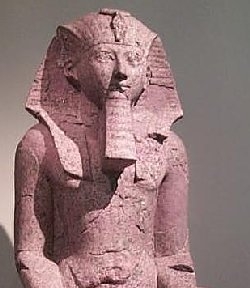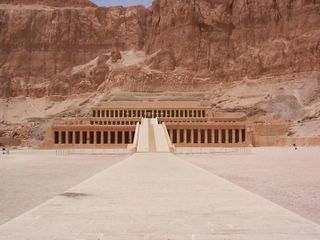Wednesday, May 25, 2005
Her Majesty King Hatshepsut
I may have found a woman that peaks my historical interest as much as or more even than the tough Caravaggist painter Artemisia Gentileschi. You may have heard of her but I never realized how powerful Queen Hatshepsut (1473-1458 B.C.) was in her 21 years as pharaoh from and how cunning she was to be able to become pharaoh despite the fact that woman pharoahs were not acceptable during that period and she was never actually genetically in line for the throne.
I don't want to give a boring history lesson, but the quick on Hatshepsut is that through a string of intermarriage and clever positioning, she somehow managed to banish her nephew, the rightful heir to the throne in Egypt to a monestary, and seize the crown herself. In order to justify her power grab, she erected a number of statues and paintings showing herself as the child of the god Amen. She also called herself "King Hatshepsut" instead of Queen and wore men's clothing and the traditional false beard worn by the pharaohs.

Here is a picture of one of her statues where she is wearing the male pharaoh garb and beard.
We saw the amazing Temple of Deir el Bahri in Luxor that Hatshepsut erected for herself. Much of the artwork was defaced by her nephew who, when he grew up, was so angry with the woman who had kept him from the throne of Egypt for years that he tried to destroy her most famous accomplishments. He destroyed her tomb and destroyed and anything on her temple that referred to her and not the gods.

Here is a picture of the Temple of Deir el Bahri.
But clearly he did not succeed in erasing her from History as he had hoped. Her rule was too enshrined and powerful for Egypt and the world to forget. During our trip down the Nile we heard about her a lot. And some 3000 years later her temple Deir el Bahri in Luxor is a tourist zoo. Not a bad legacy if you ask me!
|
I don't want to give a boring history lesson, but the quick on Hatshepsut is that through a string of intermarriage and clever positioning, she somehow managed to banish her nephew, the rightful heir to the throne in Egypt to a monestary, and seize the crown herself. In order to justify her power grab, she erected a number of statues and paintings showing herself as the child of the god Amen. She also called herself "King Hatshepsut" instead of Queen and wore men's clothing and the traditional false beard worn by the pharaohs.

Here is a picture of one of her statues where she is wearing the male pharaoh garb and beard.
We saw the amazing Temple of Deir el Bahri in Luxor that Hatshepsut erected for herself. Much of the artwork was defaced by her nephew who, when he grew up, was so angry with the woman who had kept him from the throne of Egypt for years that he tried to destroy her most famous accomplishments. He destroyed her tomb and destroyed and anything on her temple that referred to her and not the gods.

Here is a picture of the Temple of Deir el Bahri.
But clearly he did not succeed in erasing her from History as he had hoped. Her rule was too enshrined and powerful for Egypt and the world to forget. During our trip down the Nile we heard about her a lot. And some 3000 years later her temple Deir el Bahri in Luxor is a tourist zoo. Not a bad legacy if you ask me!
|